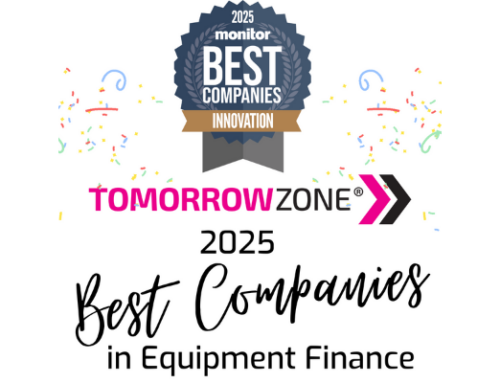
This article was originally published by MonitorDaily in August 2024.
Reprinted with permission from the author.
Alongside panelists’ tips and takeaways for balancing ‘business as usual’ with innovative business strategies, three key themes emerged from the breakout opportunities during the ELFA’s latest Innovation Roundtable: why predicting the future is so difficult, what innovation means and where innovation originates.
The latest ELFA Innovation Roundtable, hosted by Deborah Reuben, founder and CEO of TomorrowZone, on Aug. 8, focused on a prominent issue most equipment finance leaders are facing today — how to balance business as usual with forward-thinking, innovative strategies.
The “70/20/10” and Hourglass Models
Drawing on insights from two books by Peter Hinssen, keynote speaker at Monitor’s Converge 2024 conference, Reuben opened up the session with two of Hinssen’s models for business success in innovation: “70/20/10” and the hourglass.
Hinssen’s “70/20/10” rule suggests that leaders should split their focus and time into three buckets:
- 70% in “today” — business as usual, day-to-day processes that keep the organization running at an operational level
- 20% in “tomorrow” — where will the business be at the end of the quarter or the end of the year, and how will it maintain success?
- 10% in the “day after tomorrow” — how will the organization stay ahead of the curve, be prepared for disruption and foster long-term success?
Hinssen’s hourglass model splits an organizations’ efforts in half. He defines the top half as “sense and try” — screening all things “new and exciting,” like ideas, technologies, models, strategies and so forth, and taking these new concepts into a test stage with clear ingredients for change, a safe, risk-free environment and a quick approach. Essentially: if a new initiative is going to fail, make sure it’s controlled and fail fast so you can move to the next idea with minimal damage to the business.
The bottom of the hourglass is the “scale and run” portion. This is where organizations should evaluate which of the surviving concepts in the “sense and try” stage are worth further exploration and scaling out throughout the business. Importantly, this is where organizations should plan how to run these operations as smoothly as possible with a clear direction for long-term success.
The reason Hinssen places these different areas of innovation in an “hourglass” model is to emphasize that these need to be connected and the “sense and try” stage must come first. Often, he says, organizations make the mistake of pulling a team aside to “sense and try” without ever having this team come back to the rest of the organization to smoothly “scale and run” these new initiatives. As organizations test new ideas on an experimental basis in a controlled, safe-to-fail environment, any surviving concept should be immediately introduced to the people in the organization who will be scaling and running the operations, ensuring a smooth transition and a seamless execution. Plus, everyone’s on the same page in this model, which only makes the implementation of the new initiative that much smoother.
Strategies, Advice and Thought Starters
With this foundation of the session in place, special guest Nate Gibbons, chief experience officer of QuickFi, kicked off the roundtable discussion with a short introduction about the importance of thinking boldly and radically in order to challenge the status quo and get ahead. He says it’s imperative for leaders to be creative, pay attention to customers’ needs and use both of these as fuel for exploring technological solutions and making decisions.
From there, Gibbons turned the session over to Reuben and the roundtable’s panelists, including:
- John Cooper, director, NAFTA FS business solutions at CNH Industrial Capital
- Kaheres Hahn, senior vice president, technology at Finova Capital
- Jillian Munson, vice president, process and automation at QuickFi
- Darpan Saini, CEO of App0
Together, Reuben and the panelists began a deep dive into strategies, advice and thought starters for attendees to begin thinking about how to balance business as usual with the innovative mindset required for future success.
In addition to the list of takeaways from each panelist compiled by TomorrowZone and shared by the ELFA, three key takeaways emerged from the session’s breakout rooms, which offered attendees an opportunity to speak with each other and the panelists to dive deeper into the ideas and topics from the discussion.
Innovation Can Originate Anywhere
On one hand, having a team dedicated to “tomorrow” or “day after tomorrow” thinking is beneficial. That guarantees that, at any given time, someone in the organization is thinking about the near- and far-term future of the business, while others are making sure the business is operating smoothly on a day-to-day basis. On the other hand, this model runs the risk of having truly creative and motivated thinkers stuck at the “business as usual” level with no time to innovate and a limited outlet for their creativity.
During the session, Cooper said a powerful phrase: “See it, own it, solve it, do it.” If everyone in the organization has an opportunity to identify an issue, express their desire and motivation to explore and find solutions for the issue and execute on a solution with others’ input, an organizations’ opportunity for a new, innovative solution to a pressing issue is that much higher. Particularly if this is a smaller scale step in the innovative direction, i.e. the automation of an everyday process — who would know better what needs to happen than someone who is involved in this process on a day-to-day basis?
Predicting the Future is More Difficult Today
In the early 2000’s, leaders could take the age-old “where will you be in five years?” question and apply it to their company to create a business plan. With the rapid evolution of technology, innovation and curiosity, it’s becoming nearly impossible for most leaders to look that far ahead.
Imagine being a business leader in 2015 — many Monitor readers probably were. Now imagine trying to look five years into the future and create an innovative business plan. It might have worked for four of those five years, until the pandemic completely disrupted businesses across the globe. Organizations that weren’t prepared for remote work scrambled to either set up or ramp up their use of Zoom, Teams, Slack and so forth, and to shift their operations to completely remote platforms.
As many leaders would agree, something will disrupt equipment finance. Though we don’t know what, or when, industry leaders are generally concerned about a large company taking up most of the equipment finance space — just like Netflix’s domination of streaming and Blockbuster’s subsequent phasing out. Being prepared is essential, and being prepared means being innovative and getting ahead of the curve.
The Definition of ‘Innovation’ Varies
The session wrapped up with a short discussion on what innovation really means for organizations, as attendees pointed out that not every organization has the same definition of innovation, nor would these companies have the same outlook on what success with innovation looks like.
For example, bigger companies may be able to look at innovation on a much larger scale with artificial intelligence and machine learning tools that can assist in multiple areas of the business. For smaller companies, innovation may look more like automating some day-to-day process in order to free its people up for other things. It all depends on where an organization is and where an organization wants (or needs) to be.
The important thing is that leaders continue thinking big and bold, whatever that may mean for their organization, and to encourage their people to do the same.
Walk-Away Takeaways
To conclude the session, panelists offered attendees one final takeaway each:
- Munson: Innovate when you can, not when you need.
- Cooper: Innovation needs to be part of any organization’s foundation.
- Saini: Take small bites of innovation, and if something doesn’t work, don’t be afraid to get rid of it right away.
- Hahn: Keep your sizing right and properly evaluate your opportunities. It’s imperative to get the right opportunities, the right people and the right timing to innovate. Don’t wait.





